Three cultural events, the figure of the “people,” and the Kolkata winter. In this first of a two-part article, Abhishek Bhattacharyya writes about a little magazine fair and a literature festival, to be followed by another piece on a film festival.
We were standing in a group and chatting in College Square. It was a not-so-cold winter evening in Kolkata, in mid-January. The ‘little magazine’ fair was being launched with a series of performances – from plays to poetry recitations to songs. We were discussing how there were many such ‘alternative’ cultural events lined up at this time of the year, from the present event to the upcoming film festival organised by the People’s Film Collective that overlapped partially with the fair, and the People’s Literary Festival subsequently in February. One comrade in the group, who was amongst the organisers of the little magazine event, joked – you see, everyone in Kolkata remembers the “people” suddenly in winter, no one cares for the rest of the year; if only Kolkata had more of a winter, we’d probably have seen a revolution by now!
This article offers a snapshot of this people’s winter of Kolkata. Over two parts, it reports on these three cultural events, weaving in short reviews of some cultural productions encountered therein, and brief remarks about the economy of organising them for free admission, plus without accepting any government, corporate or NGO funding. In this first piece, I write about the little magazine fair, and focus on a play that was performed as part of a series of performances that accompanied the event. Little magazines are a cultural form with a lot of political potential, yet one can find remarkably little written about them in English. Despite the lack of any recent significant political ushering in the little magazine world that would break down current bounds, its tentative steps towards building an alternative space are uniquely important – given what the economy of the form allows, and also the bridges between Kolkata and the districts that are very alive in that sphere. Finally, I briefly report on the “People’s Literary Festival,” which hosted writers from around the subcontinent, building a new forum for them to meet each other. Even as it marked an engagement with a relatively limited audience, the event thought creatively around different axes of exploitation such as caste and gender. In the subsequent piece, before approaching conclusion, I write about the “People’s Film Festival,” and some films showed therein. While in itself that festival too marks a city event for middle class audiences, it is part of a broader vision for cultural interventions that involve various activities.
Nor were these the only events in town. Alternative theatre festivals and “people’s science” events have a long and very lively presence in the city, and they did this winter too. Unfortunately, I wasn’t able to attend. Neither does this piece make the effort of following up with specific forms or organisations to write a researched piece. Rather, the article precisely tries to see what cultural artefacts readily accessible in such city spaces say about alternative cultural formations. While the relative lack of reportage or academic engagement on such subjects, or its attendant obverse of celebrating it as a niche interest, may make one believe that some expedition is needed to engage them – that is quite contrary to the scene.
The Little Magazine Fair (16 – 18 January)
While we stood at the fair and joked about such spaces we work on building, and thought about how ritualistic some of them have become, their importance was clear to all. Nationally, the rise of right wing Hindutva forces has presented an increasing threat to any forms of articulation that are not amenable to its project. In general, a democratic space for expressions of difference has been under severe threat. Nor is the situation that exciting in West Bengal, where the ruling Trinamool Congress is being nationally projected as the alternative that will save the nation from the ruling party at the centre, the Bharatiya Janata Party. This souring of hopes with the TMC is reflected in the history of this fair itself.
The little magazine movement in West Bengal has a long history. Little magazines are publications usually run by individuals or small collectives of people, using their own funds, and sold for very cheap. In Bengal, they started in the first half of the twentieth century, and took on a new charge with a kind of anti-institutional politics in the 1960s, and has mutated in different ways since. While it would be inaccurate to describe this space as outside of market logics (how can such things be?) – its projects are not generally set by motives such as profitability. What is remarkable about this with regard to many other comparable literary contexts, for instance zine culture in the US, is the influence this sphere wields on the domain of the literary in Bengal. Even most established Bangla writers would have worked their way through little magazines before being picked up by prominent publishers, and would frequently continue publishing with such magazines even subsequently. Indeed, a familiar criticism levelled at many other prominent writers is about how they workshopped their writing style through little magazines, but abandoned them (i.e. started giving their better pieces to big publishing houses) once they became famous – in a cycle that often repeats itself. In other words then, these rag tag publications, often erratic and short lived, together form an important subculture which fields considerable influence on shaping a literary aesthetic.
With the aggressive attacks on peasants in the process of acquiring lands for industry, by the then Left Front government in West Bengal, the Little Magazine Samannoy Mancha (Coordination Committee for Little Magazines) decided to boycott the little magazine fair organised by the state government, and started this independent event that I attended. While many of them returned to the state organised festival after the Left Front was voted out of power in 2011, the independent fair has continued. TMC, which had then campaigned against the Left Front, is not entirely comfortable with this event either. There have been persistent issues with allocation of space for the event, and permission to hold it in College Square was only secured after much navigation last moment this year. This is noteworthy further because TMC earlier banned all forms of protest at College Square, which has for long been a go-to place for a variety of political gatherings in Kolkata.
Yet, while the continuance of the fair is a significant event, there remain different ways in which it could be strengthened. For instance, most magazines have a special issue for the Kolkata Book Fair that was two weeks away at that point – an event organised with state and corporate support. The little magazine editors could have prepared their special issues two weeks early, if not done a special issue for this fair itself, and this would have encouraged more reader participation in their alternative event. As it turned out, many were yet to get their book fair issues in place, and were selling earlier issues. If it is possible to build new movements, perhaps projects such as these can be further strengthened with fresh enthusiasm, especially with involvement of more young people.
This year there were around 80-100 tables with little magazines at the fair. One of the organisers said that over its three days, he estimates about a 1000 people would have visited. I was attending this alternative fair after a long time, and went after a visit to the bank, with hopes of buying whatever exciting books I found. I soon realised that here cost would be an issue in a different way – I didn’t risk so much running out of money, rather I risked running out of short change. The publication costs started at Rs. 10, and barely touched Rs 100 in some instances. Of course, there were more expensive texts as well, but they were difficult to spot. One can hardly try to buy a magazine for Rs. 30 by handing out a Rs. 500 note! This experience with low denomination notes again made starkly clear for me, how the basic project of most of these magazines is to reach diverse readerships, so that cost does not come as a hindrance. Nor do the writers or publishers usually turn profits from them – often they are subsidised from their pockets and run at a loss. Moreover, the fair is exciting also because one gets to chat with editors and writers sitting at the tables, selling their publications, mostly friendly and eager to talk with known and unknown people.
A “Cultural festival to resist communalism and fascism” was added to the roster this year. Over four days (starting a day before the fair), the festival included performances of different kinds: poetry recitations, songs and plays by individuals and collectives from Kolkata as well as other districts. I watched a number of them over the two days that I attended. Many articles could have been written about them (though I haven’t noticed one yet), and while it will not be possible here to discuss so many different projects, I’ll pause on one which shows some important strengths of forums like these, and also suggests the depth (in time and dispersion) of such work.
“Obokkhoy” has been working as an organisation in Chakdaha (Nadia district) for 21 years now, I learnt from Mrinal Bagchi, who is an active member. They’ve been teaching kids from economically disenfranchised and other marginal backgrounds, with about a hundred students currently enrolled. They do not accept any funding from the government, NGOs or corporations, Mr Bagchi continued. They also organise free medical camps in different places, I learnt. And different “third theatre” groups – such as Pathasena, Satabdi, Ayna – have worked with them at different points. They have relationships with 14 friendly publication houses who give them books at different points, with which they set up book stalls in Chakdaha, and also participate actively in the annual Chakdaha Book Fair. Chakdaha also has prominent proscenium theatre groups, and a month long theatre festival, but the plays there aren’t affordable for any of these people, Mr Bagchi said, while discussing their multipronged work on education, health, reading practices and performance. Such projects of staying in various places and educating kids itself has a long history within the Indian left, and is a story that needs to be told. In this instance, I was meeting them in the context of a performance by some of their students at the festival. Directed by “Chena Adhuli”s Rajat Das (Bapi), and scripted by Dulal Kar, the play was called “Ashroy” (Shelter).
I accompanied my friend, Nandini Dhar, who is also the co-editor of a little magazine, as she spoke to the young actors, mostly girls – all between 12 – 16 years of age. They discussed their experiences of workshopping plays, and told us about a play they’d themselves developed in the process. This play had begun at a Saraswati puja adda, where news arrives that a woman had gone missing, and then all the women in the locality organise in protest, take out a rally, face ridicule from neighbours, but finally manage to persuade and prevail in some way. The whole process of conversations and theatre games, including developing this earlier play, had gone on for over three months, they said, before they started work on this play by Dulal Kar over another two and half months.
While the play had already been performed eight times in different places, including in Chakda – for almost all of them this was their first time visiting Kolkata, and they were visibly thrilled to be performing in such a space. Before rushing to catch their trains back, they told us about the importance of such plays which protested the diverse oppressions and violence experienced by women. On being asked by Nandini why they chose these specific issues – they spoke of the importance of educating people about how women too can do everything, and should not be held back by society. They told us about how even they have sometimes been the target of rumours – few neighbours have insinuated they may be involved in some kinds of undesirable activity, and have questioned the need for theatre at a place supposedly for the education of children. Why do they continue with the play, in the face of such pressures? Pat came the answer: they enjoy doing this. Some others followed, explaining the social importance of trying to educate people. It was precious to witness this conversation: a group of young kids and teenagers, mostly girls, who live lives that many us who may be reading pieces like this would find difficult to imagine, telling us about their views on sexual violence, and how theatre can help the fight back. How not to be moved by them, or feel grateful for the existence of such an educational institution, theatre group, and little magazine festival organisers – who all made this possible?
Simultaneously, the shortcomings of the final performance are also indicative of broader issues. The play told a story of sexual violence, and how a woman is abandoned by everyone, including her family, after she is raped. In doing this with such young people, and in such a sensitive manner (as previously mentioned, the actors afterwards were themselves telling us of the importance of such projects politically, and had clearly been involved in discussing the matter), the process of putting the play together had initiated a vital process of awareness about these subjects and how to negotiate them, where such discussions would often be taboo. Yet, as another friend pointed out, in this play centred on a dramatisation of sexual violence, there was no discussion of sexual pleasure, without which the question of sex itself risks getting lost to the violence that often structures it, potentially reinforcing taboos around discussing, thinking of or seeking sex.
There also wasn’t much by way of hints towards less dramatic but more regular processes of sexual violence experienced by kids (or adults), discussing which could have been a helpful part of the educational process. In terms of its energy curve, the play also marked a tragic tone from the get-go and continued in that vein – it could have had more punch with variations in tempo on stage. In critiquing the role of this performance at an event such as this one, its relationship to the audience is also an important factor. For instance, at one point a character asked a passer-by who was helping the abandoned woman, what his caste was, and he replied that he is a poor person, rhetorically adding: what other caste does a poor person have? This dialogue was met with applause by a section of the audience (which didn’t applaud at any other point during the play), appearing to chime with a denial of caste within significant sections of such alternative gatherings. To be clear: caste was explicitly the subject of other performances, and different little magazines available at the festival have done irreplaceable work in the study of caste structures in Bengal (from research on caste, to translations of writers from other languages, to publications run by dalit writers), and even this particular play included dalit participants. At the same time, the warm reception of a dialogue that was interpreted as glossing caste in terms of class, also marked that space.
The People’s Literary Festival (15-16 February)
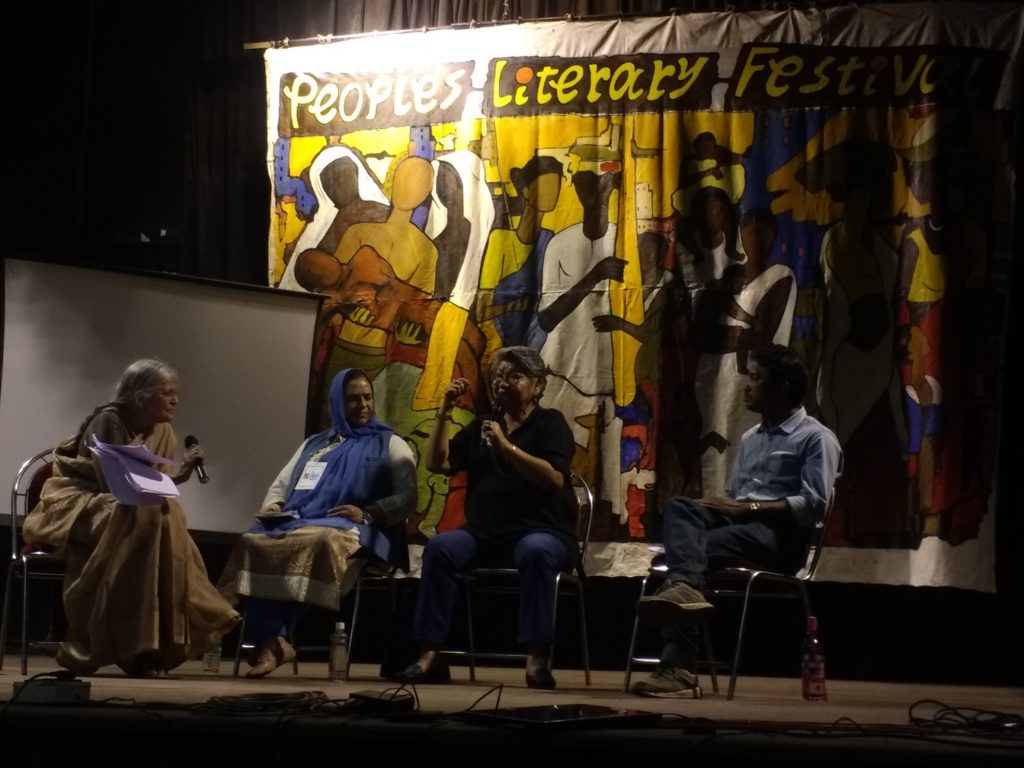
Monalisa Changkija, journalist and poet from Nagaland, speaking at the festival. To her left is Odiya poet Hemanta Dalapati. To her right is Kashmiri writer Anjum Zamarud Habib, and to her right moderator Nisha Biswas.
The speakers at the People’s Literary Festival organised by the Bastar Solidarity Network (Kolkata Chapter) were curated to think creatively about different axes of oppressions, and included a diverse array of speakers. Where the organisation of the little magazine fair was primarily headed by middle aged or elderly men, the BSN organisers – while still being largely upper caste, middle class – were a more gender diverse and young group. Overall, men were a minority on the panels, speakers were from different caste backgrounds. Articles by members of BSN – Tamoghna Halder in English, and Sananda Dasgupta in Bangla – provide helpful overviews of the way the panels and speakers were organised. This was the second such event organised by BSN in Kolkata (here is a report on the first one, here a piece by BSN last year), and it is building a very exciting space for learning about radical writing from around the Indian subcontinent. The over twenty speakers ranged from members of the Revolutionary Writers Association of Andhra and Telangana, to the initiator of Miya poetry in Assam, to a writer from Kashmir, to writers from Pakistan who were denied visas and joined through videos.
Describing their aims, BSN argued the festival is organised:
… to celebrate writers and artists who have relentlessly questioned the powers that be, who have repeatedly tried to bring to the fore stories of the people the state wants to obliterate from our ‘collective conscience’. It is to problematise the sanitised space of corporate literary festivals and bring in voices that raise uncomfortable questions, push us out of our comfort zones and confront hard truths, to listen to movements that challenge the status quo, to find poetry in songs and slogans that declare war against this fascist Brahminical state. We further note how scared the state can be when resistance shapes up in the form of art and literature. Recall how author Sudhir Dhawale’s prosecution alleges him to be guilty of quoting Brecht in a popular Marathi play. The People’s Literary Festival, therefore, commits to nurture the revolutionary potential of the literary world by connecting such writers among themselves as well as with their readers.
Given the quality of the discussions, and the presence of speakers one does not often get the opportunity to hear, it was unfortunate to see that the event was not better attended, featuring at best a couple of hundred people in the audience in a day. Of course, that itself is no mean feat – especially for these times, but even otherwise. And any new project needs time to build a space for itself. We can gain a sense of what they are up against (in their new attempt, addressing entrenched issues that work to contain such voices – from the general political climate to specific acts such as active censorship) by looking at one illustrative issue, that of language. On the one hand, bringing such a diverse array of writers from around the subcontinent into conversation, along with a local moderator for every panel who was well prepared and could root the discussions, presented a productive channel for engaging Kolkata based readers, who may generally not know about all this exciting work happening around the country. Given how isolating the process of writing, and that too writing from the margins of society can be, this kind of festival can go a long way in creating a sense of community amongst writers, as well as expanding audiences, readerships and conversations in a different region. Yet, while the organisers worked on mixing up the languages (between Bangla, Hindi and English) within panels to engage different members of the audience and visiting speakers, the heavy reliance on English also presented a difficulty in engaging a broader audience, and would be a limiting factor for further participation in such an event. The problem is complemented by the fact that many of the visiting writers have never been translated into any language, let alone into Bangla. To support and create spaces for such conversations, it is also vital that we all take it upon ourselves to work towards more inter-regional translations, to make these writers accessible to different readerships.
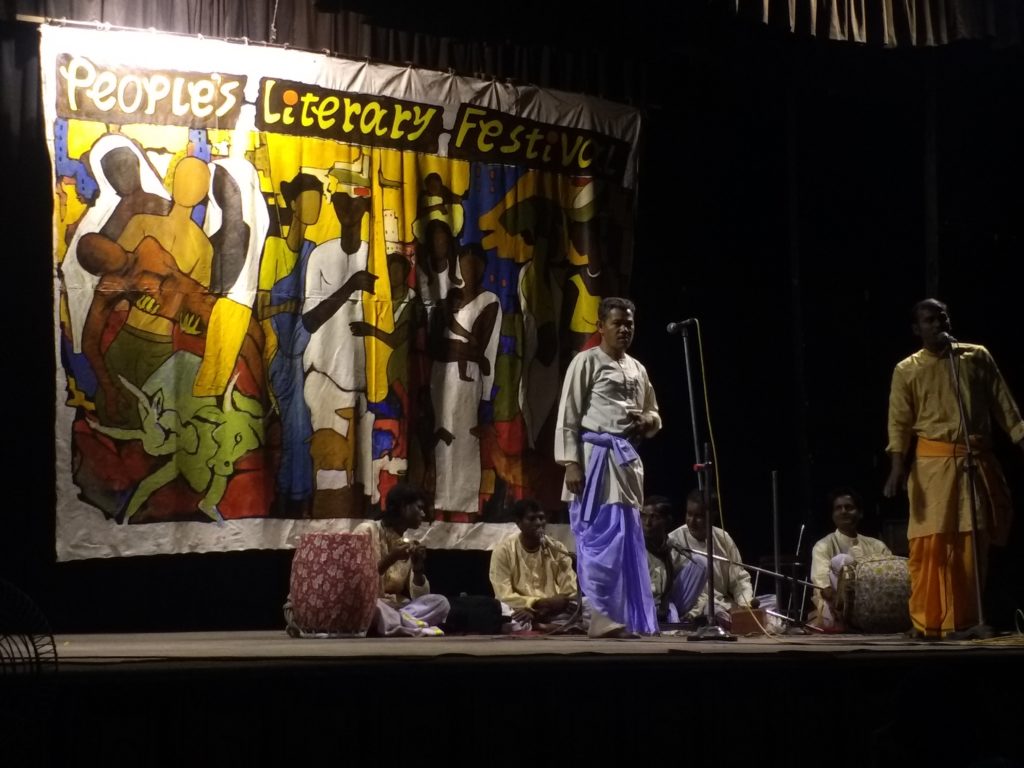
Gokul Hazra, Pranesh Mohan Pal and others perform “kobigaan” – a local performance tradition including debates through songs.
Until part two of this article …
The two literature festivals discussed here – one pertaining to little magazines mostly from West Bengal, the other with writers from across the subcontinent – and the different forms and people it brought together, all have their own histories. They are part of the history of leftist education projects, theatre, writing, political trajectories, and more. At the same time, they are also coalesced into these forms by particular contemporary political conjunctures – whether one thinks of the protests against dispossession of peasants in West Bengal leading to the alternative little magazine fest, or the state repression of adivasi people in Chattisgarh leading to the creating of Bastar Solidarity Network. While it remains to be seen how they are imaginatively taken forward, and what our roles in such a process may be, in the meantime they are building important spaces.
For the next part of this article, I will look at the film festival organised by the People’s Film Collective, and try to bring together some overall remarks about the people’s winter of Kolkata!
(Abhishek Bhattacharyya (obhishekbolchi@gmail.com) is a doctoral student and activist; all photos are by him. Cover photo: people crowd around book stalls at the People’s Literary Festival in Sukanta Mancha)

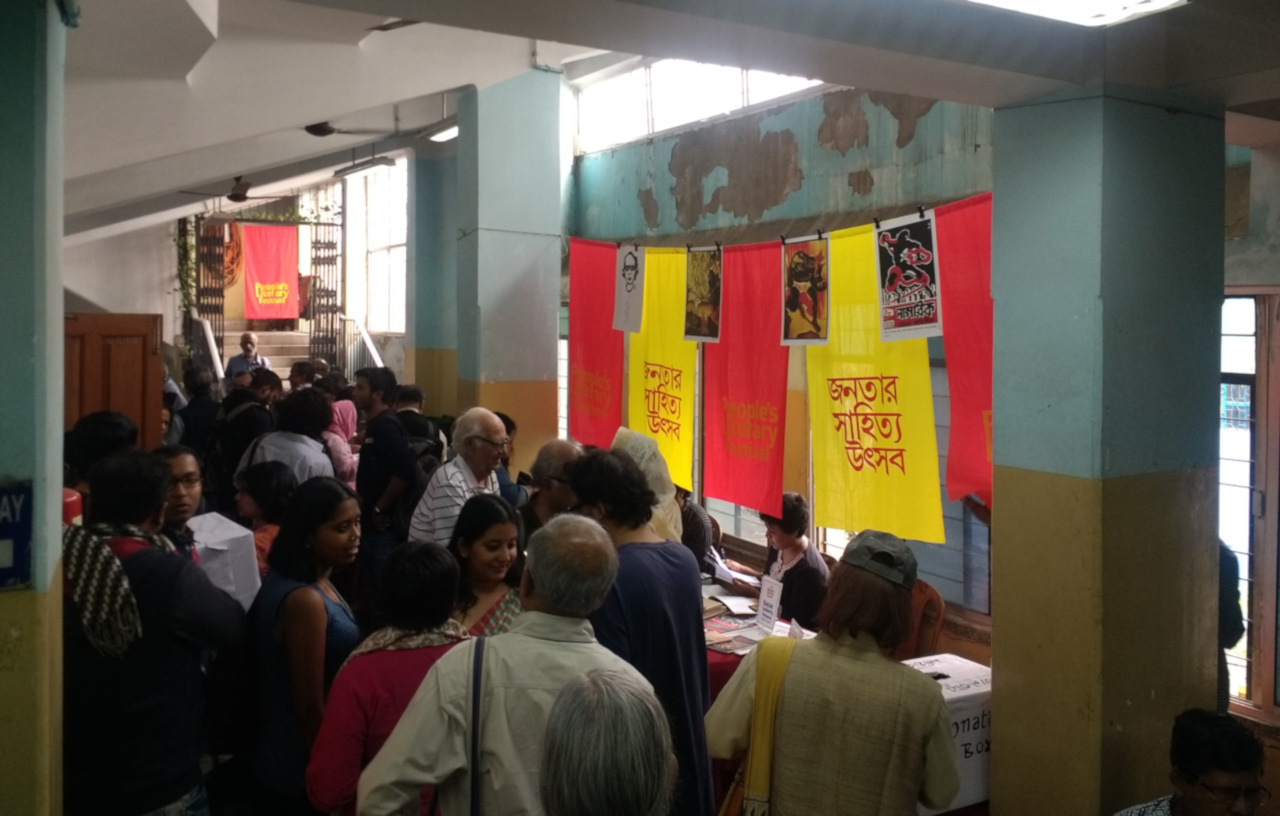
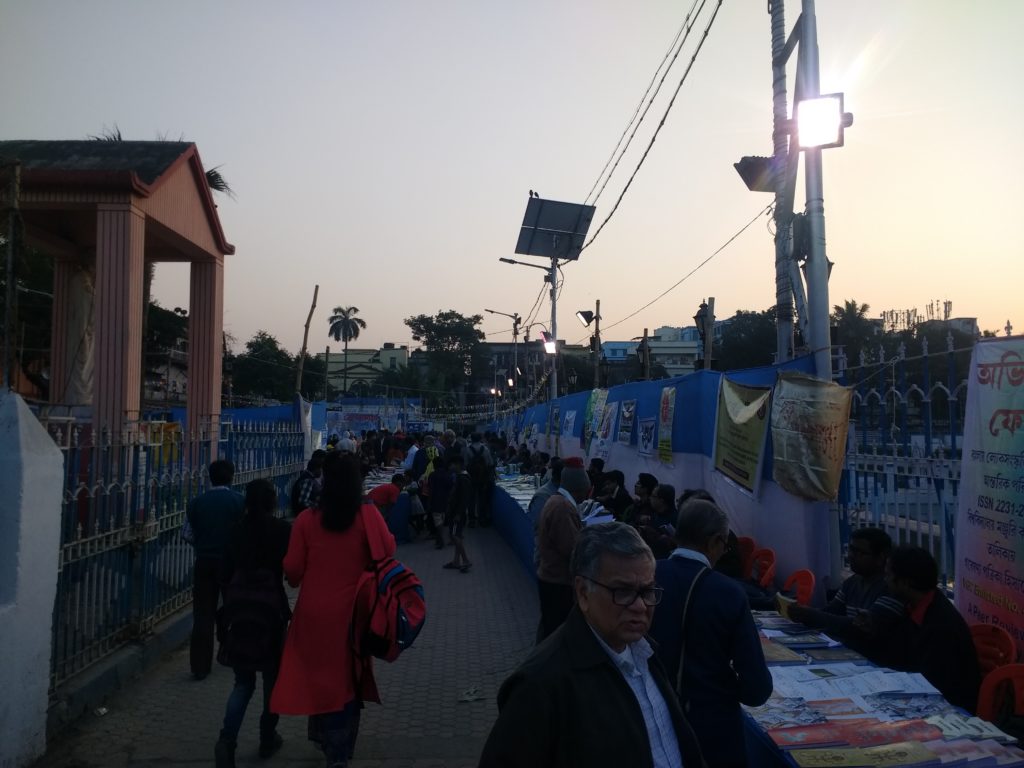
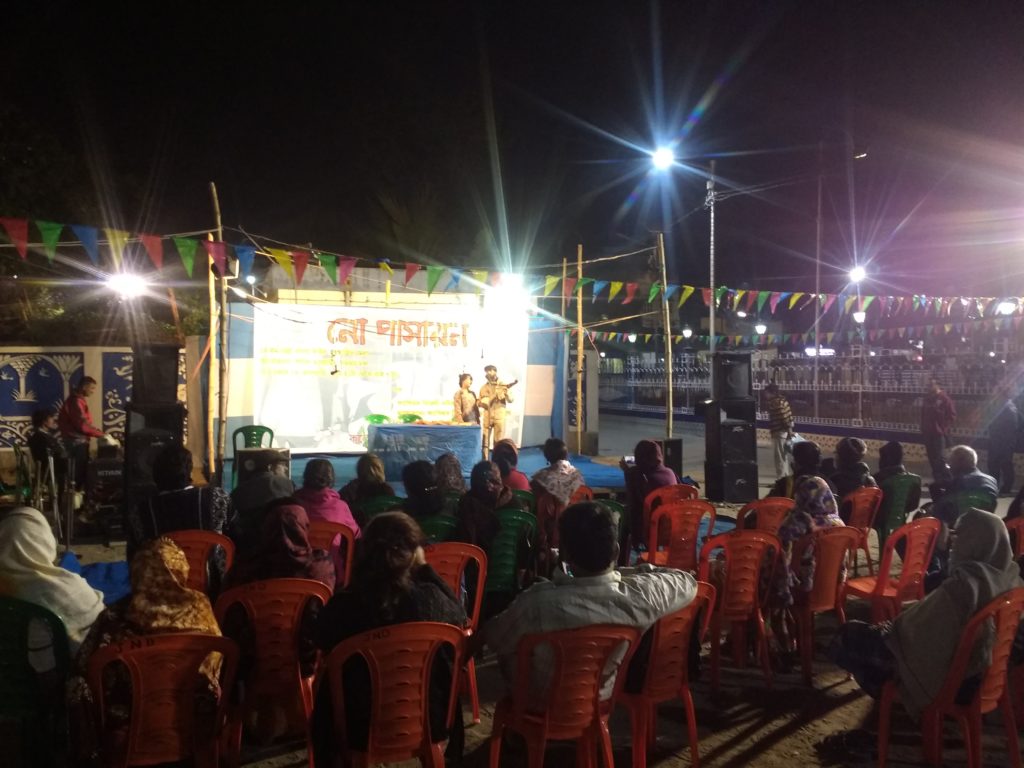


[…] SOURCE: https://www.groundxero.in/2019/03/15/the-peoples-winter-of-kolkata-little-magazines-and-literature-f… […]